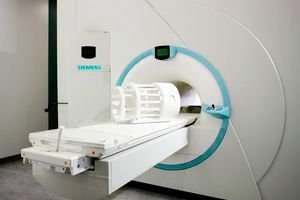
All iLive content is medically reviewed or fact checked to ensure as much factual accuracy as possible.
We have strict sourcing guidelines and only link to reputable media sites, academic research institutions and, whenever possible, medically peer reviewed studies. Note that the numbers in parentheses ([1], [2], etc.) are clickable links to these studies.
If you feel that any of our content is inaccurate, out-of-date, or otherwise questionable, please select it and press Ctrl + Enter.
Magnetic resonance spectroscopy
Medical expert of the article
Last reviewed: 07.07.2025

Magnetic resonance spectroscopy (MR spectroscopy) provides noninvasive information on brain metabolism. Proton 1H-MR spectroscopy is based on the "chemical shift" - a change in the resonance frequency of protons that make up various chemical compounds. This term was introduced by N. Ramsey in 1951 to denote the differences between the frequencies of individual spectral peaks. The unit of measurement of the "chemical shift" is a millionth part (ppm). Here are the main metabolites and their corresponding chemical shift values, the peaks of which are determined in vivo in the proton MR spectrum:
- NAA - N-acetyl aspartate (2.0 ppm);
- Cho - choline (3.2 ppm);
- Cr - creatine (3.03 and 3.94 ppm);
- ml - myoinositol (3.56 ppm);
- Glx - glutamate and glutamine (2.1-2.5 ppm);
- Lac - lactate (1.32 ppm);
- Lip - lipid complex (0.8-1.2 ppm).
Currently, two main methods are used in proton MR spectroscopy - single-voxel and multi-voxel (Chemical shift imaging) MR spectroscopy - simultaneous determination of spectra from several areas of the brain. Multinuclear MR spectroscopy based on the MR signal of phosphorus, carbon and some other compounds has also come into practice.
In single-voxel 1H-MR spectroscopy, only one area (voxel) of the brain is selected for analysis. By analyzing the frequency composition in the spectrum recorded from this voxel, a distribution of certain metabolites is obtained on the chemical shift scale (ppm). The ratio between the metabolite peaks in the spectrum, a decrease or increase in the height of individual spectrum peaks allow a non-invasive assessment of the biochemical processes occurring in the tissues.
Multivoxel MP spectroscopy produces MP spectra for several voxels at once, and allows comparison of spectra of individual areas in the study area. Processing of multivoxel MP spectroscopy data makes it possible to construct a parametric map of the section, on which the concentration of a certain metabolite is marked in color, and to visualize the distribution of metabolites in the section, i.e. to obtain an image weighted by chemical shift.
Clinical application of MR spectroscopy. MR spectroscopy is currently widely used to evaluate various volumetric lesions of the brain. MR spectroscopy data do not allow for a reliable prediction of the histological type of neoplasm, however, most researchers agree that tumor processes are generally characterized by a low NAA/Cr ratio, an increase in the Cho/Cr ratio, and, in some cases, the appearance of a lactate peak. In most MR studies, proton spectroscopy was used in the differential diagnosis of astrocytomas, ependymomas, and primitive neuroepithelial tumors, presumably determining the type of tumor tissue.
In clinical practice, it is important to use MR spectroscopy in the postoperative period to diagnose continued tumor growth, tumor recurrence, or radiation necrosis. In complex cases, 1H-MR spectroscopy becomes a useful additional method in differential diagnostics along with perfusion-weighted imaging. In the spectrum of radiation necrosis, a characteristic feature is the presence of the so-called dead peak, a wide lactate-lipid complex in the range of 0.5-1.8 ppm against the background of a complete reduction of the peaks of other metabolites.
The next aspect of using MR spectroscopy is the distinction between newly detected primary and secondary lesions, their differentiation from infectious and demyelinating processes. The most indicative results are the diagnostics of brain abscesses based on the use of diffusion-weighted images. In the spectrum of the abscess, against the background of the absence of peaks of the main metabolites, the appearance of a peak of the lipid-lactate complex and peaks specific to the contents of the abscess, such as acetate and succinate (products of anaerobic glycolysis of bacteria), amino acids valine and leucine (the result of proteolysis) is noted.
The literature also widely studies the information content of MR spectroscopy in epilepsy, in the assessment of metabolic disorders and degenerative lesions of the white matter of the brain in children, in traumatic brain injury, cerebral ischemia and other diseases.


 [
[